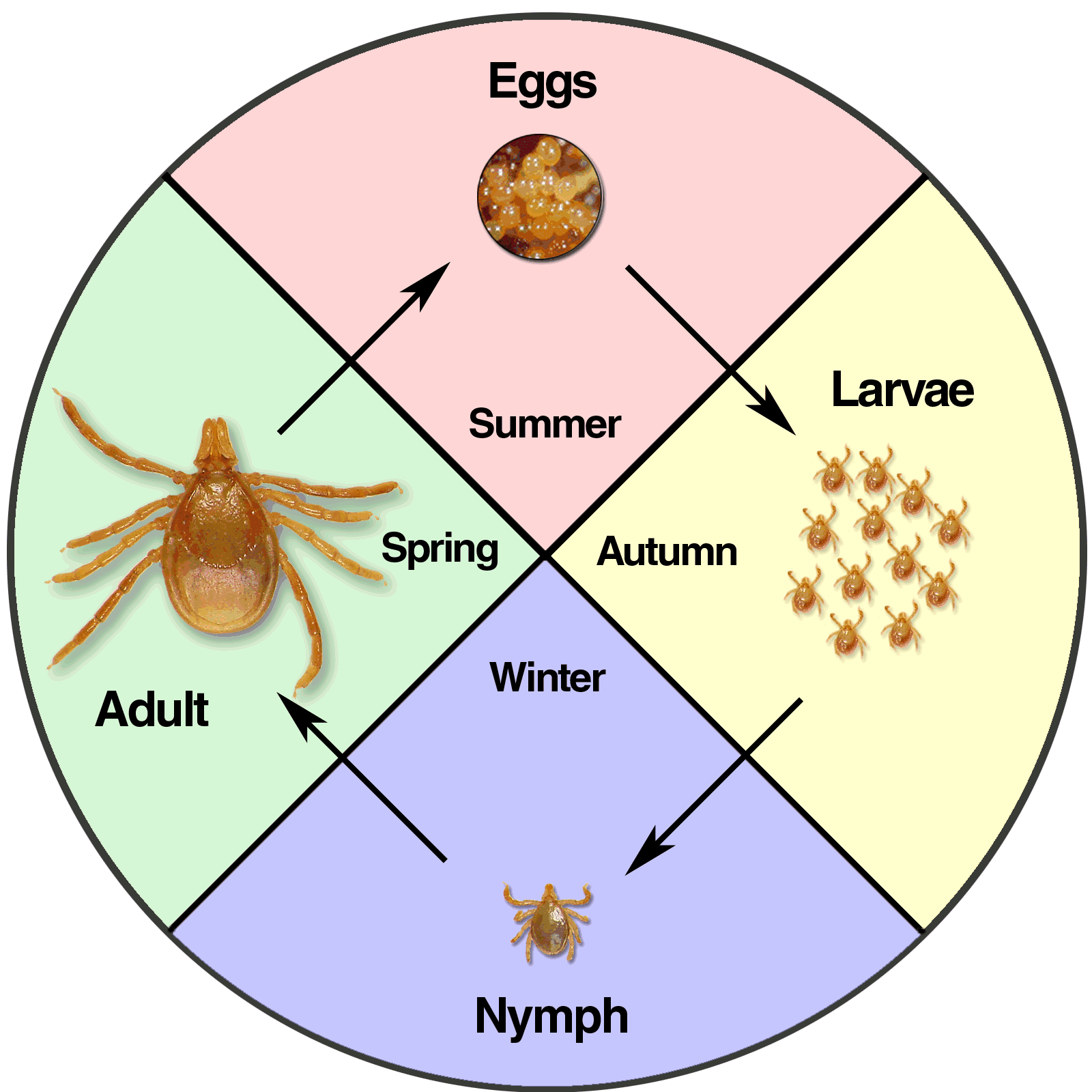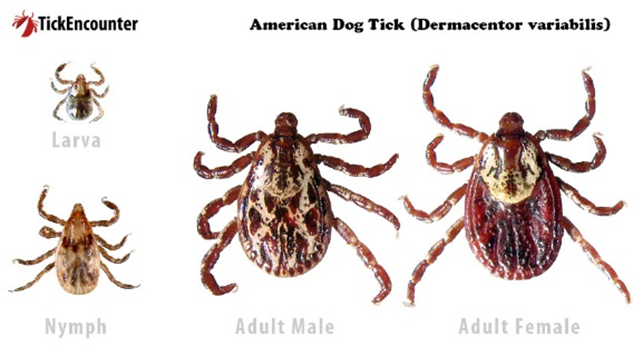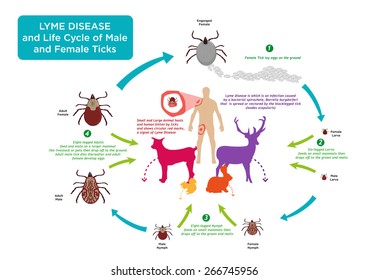tick life cycle uk
The larva is very small less than a millimeter in length only has six. DO THE TICK CHECK Ticks prefer warm moist dark areas of the body.
Ticks Effects Control And Life Cycle
Their life cycle takes several different transitions.

. About 8 weeks after being laid the second stage of the life cycle begins when a larva emerges from each egg. It takes 3 to 36 months for ticks to complete their lifecycle. Generally there are two peaks of tick activity in the spring and in the late summerautumn.
The ticks will dry out and die within 24 hours. Once laid eggs will take between 36 and 57 days to hatch. The first stage of a ticks life is as an egg.
Life Cycle of Ticks. Feeds once at each developmental stage and as the tick often feeds only once a year in the UK the whole cycle from egg to adult can take three years. In essence each large feed will give them the blood meal necessary for them to grow into the next stage.
The life cycle of a tick. Egg larva nymph and adult. Ticks that feed on mammals birds reptiles and amphibians are known as blacklegged ticks.
Once a tick hatches from their egg they enter the second stage of their life. Larvae nymphs and adults. Basically the tick needs three distinct blood meals for it to complete its development.
Ticks The Risks Tick family Ticks UK Ireland. Ticks that require this many hosts can take up to 3 years to complete their full life cycle and most will die because they dont find a host for their next feeding. The life cycle of ixodids can take from 1 to 6 years and involves 4 stages.
In the USA the highest risk comes from the Deer tick Ixodes scapularis but this is not known in Europe. There are four stages to a ticks life-cycle. Stages in the Life Cycle of Ticks.
The nymph then seeks another host feeds drops off and moults to the adult stage. The cycle begins with an adult female laying eggs in the shelter of grass from which larvae will hatch when the weather warms in spring. Tick biology and ecology Ticks in the UK Tick-borne Disease in the UK National Tick Survey Lifecycle of a tick Tick life cycle Tick life cycle Environmental Conditions Suitable habitat moorland woodland etc Host availability Soil threshold temperature.
The eggs hatch and six-legged larvae emerge from the eggs. Without blood ticks cant do any of this. A tick starts life as an egg and because tick mortality is so high the female tick lays as many as 18000 eggs in the ground.
Requires high humidity almost saturation to prevent dehydration on the ground so it tends to be found in wetter areas particularly in the West and Northern England and Scotland. They need the dry to die. Most ticks go through four life stages.
The life cycle takes on average three years to complete. Now let us look at their life cycle to get a better understanding. Aside from its missing set of legs the larva looks a lot like an adult tick.
The life cycle of a tick is completed after four stages namely egg larva nymph and adult it requires more than a year to complete a full life cycle. However ticks are also often found on lower lying areas of rougher grazing field boundaries etc. After hatching from the eggs ticks must eat blood at every stage to survive.
Ticks go through four life stages. This is the safest way to handle your outdoor clothing as ticks can survive a full cycle in the washing machine. Many ticks go through a three host life cycle meaning that they parasite three different host bodies during their lifetime.
During its life the tick will feed on three different hosts. Ticks are a group of parasitic arachnid species similar to spiders scorpions and mites that range between 05 - 11mm in size depending on the lifecycle. There are four stages to a ticks life-cycle.
The tick life cycle is made up of three active stages. Egg larva nymph and adult. Ticks of the Ixodes scapularis species have a two-year life cycle.
Ticks need energy from blood in order to grow develop and lay eggs. Each stage needs an animal host on which to feed before it can moult to the next stage or in the case of the adult females lay eggs. After hatching the larva seeks a host feeds and then drops off to moult to the nymphal stage.
Feeds once at each developmental stage and as the tick often feeds only once a year in the UK the whole cycle from egg to adult can take three years. A tick begins its life as an egg. The Brown Dog Tick Rhipicephalus sanguineus has been brought into the UK from Europe on dogs and can survive and reproduce inside a home unlike the native UK ticks.
A hot room or on a hot windowsill. Many ticks go through a three host life cycle meaning that they parasite three different host bodies during their lifetime. A female tick will lay anywhere between 4000 and 6500 eggs.
Ixodes scapularis the black-legged deer tick which is the primary vector for Lyme disease has a four-stage life cycle and a lifespan of about two years. Ticks have four stages of their life cycleeggs larvae nymphs and adult ticksand every stage except the eggs feeds on blood. 17-20C Relative humidity above 80 Ticks as disease vectors.
Ticks hatch from there eggs in the spring or summer months. The life cycle of a deer tick consists of four stages beginning with an egg laid by a mature female. Check the whole body.
Larvae and nymphs prefers small to medium-sized animals and adults tend to feed on. This period is dependent on the availability of animal hosts their location and the temperatures of the surroundings. The tick egg hatches out into a larva.
After hatching from the eggs ticks must eat blood at. To survive once the eggs hatch the ticks require a blood meal at every stage. They go through four phases of development during this time.
The First Stage egg The adult female tick first fulfills a proper blood meal then the process of mating occurs between an adult male and adult female tick. Egg larva nymph and adult. By Centers for Disease Control and Prevention.
Ixodes ricinus is a three-host tick with larvae nymphs and adults feeding on different hosts. 1 The Egg Stage 1 After the adult female tick has acquired a proper blood meal she mates with the adult male tick leaves the host and searches for a suitable spot to lay her eggs. Egg six-legged larva eight-legged nymph and adult.
Its important to be familiar with this life cycle to get rid of ticks from your lawn and landscape and prevent tick bites. It may be helpful to have someone else. When the egg hatches a six-legged larva emerges.
Ticks are a clear illustration of how food works as an energy source. Ticks survive by feeding off mainly bird and mammal hosts such as farm animals wildlife our cats and dogs and us humans. Life cycle of ticks family.
Lifecycle of a tick. The larva has only six legs. As well as causing irritation on the skin when feeding they are a.
This means that tick larvae and nymphs as well as full-grown adult ticks need to bite a host such as a human or a wild animal and suck its blood in order to survive.

Specieswatch Ixodes Ricinus Tick Insects The Guardian

Trek Tragedy Review On Lyme Disease Rcemlearning

An Overview Of Tick Paralysis Symptoms Treatment And Prevention

Conceptualizing The Digital Life Cycle
Ticks Effects Control And Life Cycle

The Tick Life Cycle Printed With Permission From Jeremy Gray Eucalb Download Scientific Diagram

The Tick Lifecycle Lyme Tick Borne Disease Testing Statistics

Life Cycle Of Ixodes Ricinus And Transmission Of Rodent Associated Download Scientific Diagram

What Are Seed Ticks And Are They Dangerous

Ticks And Disease In Kentucky Entomology

Tick Season Is Upon Us Larkmead Veterinary Group

Deer Tick Images Stock Photos Vectors Shutterstock

Tick Vector An Overview Sciencedirect Topics
Life Cycle Visa Vis Symposiums

Pathogens Free Full Text Experimental Infection Of Ticks An Essential Tool For The Analysis Of Babesia Species Biology And Transmission Html



